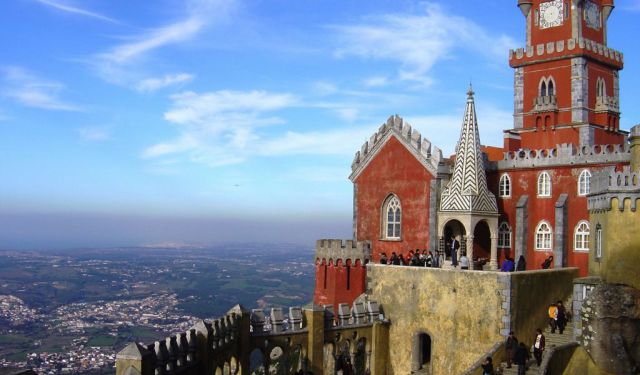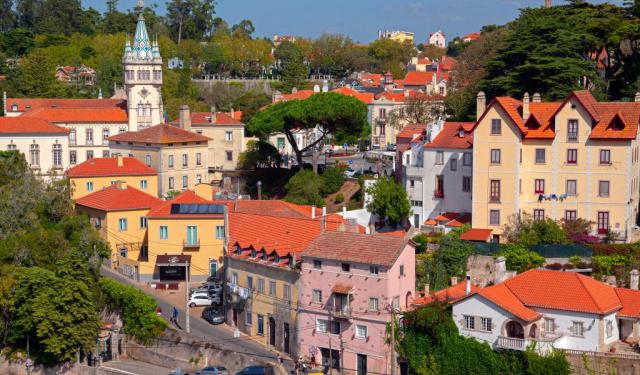
Palácio Nacional da Pena (Pena National Palace), Sintra (must see)
The Pena National Palace sits on top of a high hill of the Sintra Mountains. On a clear day it can be seen from Lisbon. It is a multi-colored restored royal palace, an important expression of 19th century Romanticism. It was not always so.
In the Middle Ages, tales of an apparition of the Virgin Mary prompted construction of the chapel of Our Lady of Pena. The chapel became a popular destination for pilgrims. In 1493, King John II of Portugal and his spouse, Queen Leonor, came to pay homage. Seeing the magnificence of the site, he ordered a monastery built.
The monastery was given to the Order of Saint Gerome. It harbored a small company of monks. The Great Earthquake of 1755 leveled everything, but the chapel was mostly spared.
In the early 1800s King Ferdinand, impressed by the miracle on the mountain, decided to rebuild the old monastery. He also ordered a castle for the royal family. Baron Wilhelm Ludwig von Eschwege, a German architect, was hired to make Pena Palace.
The Palace is complex. There is the restored monastery with clock tower, a chapel yard, walls of arches, two gateways, a drawbridge and a cylindrical bastion with a "cathedral" interior. The Palace is a melange of medieval, Renaissance, neo-Gothic, neo-Islamic, neo-Renaissance and neo-Manueline styles with a distinct Romantic ambience inside and out.
The king had taken the shrine and turned it into a folly. But what a folly it is! The visitor is taken to exotic fairylands. The clock tower, completed in 1843, is a part of the Queen's Terrace. It has a sundial and a cannon, meant to be fired at noon. Does it disturb meditations in the chapel? The monks did not complain.
The park around the castle contains trees from around the world. Magnolias, Japanese Cryptomeria, Ginko, Sequoia, Cypresses and Cedars fill the Queen's Fern Garden. Hans Christian Anderson, Richard Strauss and Lord Byron have thought the place a castle of the Holy Grail. The Palace is a National Monument and a jewel in the crown of Sintra.
In the Middle Ages, tales of an apparition of the Virgin Mary prompted construction of the chapel of Our Lady of Pena. The chapel became a popular destination for pilgrims. In 1493, King John II of Portugal and his spouse, Queen Leonor, came to pay homage. Seeing the magnificence of the site, he ordered a monastery built.
The monastery was given to the Order of Saint Gerome. It harbored a small company of monks. The Great Earthquake of 1755 leveled everything, but the chapel was mostly spared.
In the early 1800s King Ferdinand, impressed by the miracle on the mountain, decided to rebuild the old monastery. He also ordered a castle for the royal family. Baron Wilhelm Ludwig von Eschwege, a German architect, was hired to make Pena Palace.
The Palace is complex. There is the restored monastery with clock tower, a chapel yard, walls of arches, two gateways, a drawbridge and a cylindrical bastion with a "cathedral" interior. The Palace is a melange of medieval, Renaissance, neo-Gothic, neo-Islamic, neo-Renaissance and neo-Manueline styles with a distinct Romantic ambience inside and out.
The king had taken the shrine and turned it into a folly. But what a folly it is! The visitor is taken to exotic fairylands. The clock tower, completed in 1843, is a part of the Queen's Terrace. It has a sundial and a cannon, meant to be fired at noon. Does it disturb meditations in the chapel? The monks did not complain.
The park around the castle contains trees from around the world. Magnolias, Japanese Cryptomeria, Ginko, Sequoia, Cypresses and Cedars fill the Queen's Fern Garden. Hans Christian Anderson, Richard Strauss and Lord Byron have thought the place a castle of the Holy Grail. The Palace is a National Monument and a jewel in the crown of Sintra.
Want to visit this sight? Check out these Self-Guided Walking Tours in Sintra. Alternatively, you can download the mobile app "GPSmyCity: Walks in 1K+ Cities" from Apple App Store or Google Play Store. The app turns your mobile device to a personal tour guide and it works offline, so no data plan is needed when traveling abroad.
Palácio Nacional da Pena (Pena National Palace) on Map
Sight Name: Palácio Nacional da Pena (Pena National Palace)
Sight Location: Sintra, Portugal (See walking tours in Sintra)
Sight Type: Attraction/Landmark
Guide(s) Containing This Sight:
Sight Location: Sintra, Portugal (See walking tours in Sintra)
Sight Type: Attraction/Landmark
Guide(s) Containing This Sight:
Walking Tours in Sintra, Portugal
Create Your Own Walk in Sintra
Creating your own self-guided walk in Sintra is easy and fun. Choose the city attractions that you want to see and a walk route map will be created just for you. You can even set your hotel as the start point of the walk.
Pena Palace and Moorish Castle Tour
A charming little township on the outskirts of Lisbon, Sintra is a place where there's something for everyone. As if straight out of a fairy tale, this area is a home to several magnificent castles, palaces and gardens, the grandiosity of which fits for a king; and it has been a firm favorite of Portuguese royals since the late 15th century.
The diversity of styles found here is rich –... view more
Tour Duration: 2 Hour(s)
Travel Distance: 3.5 Km or 2.2 Miles
The diversity of styles found here is rich –... view more
Tour Duration: 2 Hour(s)
Travel Distance: 3.5 Km or 2.2 Miles
Sintra Introduction Walking Tour
Traces of humanity in Sintra date back to Paleolithic times. At an open air site near the church of Sao Pedro de Canaferrim and the Moorish Castle there were found ceramics from 5,000 BC. The name Sintra is indo-European. It means "bright star" or "sun." Romans called the place "sacred mountain." Ptolemy called it "mountains of the moon."
In 1147 the... view more
Tour Duration: 1 Hour(s)
Travel Distance: 2.0 Km or 1.2 Miles
In 1147 the... view more
Tour Duration: 1 Hour(s)
Travel Distance: 2.0 Km or 1.2 Miles


